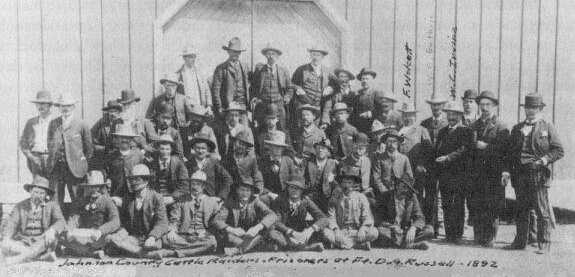
Johnson County Invaders, prisoners at Fort D. A. Russell, 1892, photo by Charles D. Kirkland
L to R, 1st Row seated: W. Little, Jeff Mynett, Bob Barlings, S. Sutherland, Buck Garrett, G. R. Tucker,
J. M. Benford, Will Armstrong.
2nd Row seated: W. H. Tabor, J. A. Garrett, W. A. Wilson, J. Harlings, M. A. McNally, Mike Shonsey, Frank Canton.
3rd Row standing: Tom Smith, A. B. Clarke, J. N. Leslie (short individual in "Boss of the Plains" hat), E. W. Whitcomb, Frederic O. DeBillier, Ben Morrison, W. J. Clarke, Hubert E. Teschemacher, B. C. Schulze, Fred Hesse
(short individual in "Dakota" style hat), Major Frank Wolcott, W. C. Irvine, Joe Elliott, Scott Davis. Behind
Wolcott, Irvine and Davis are W. E. Guthrie, Bob Tisdale (in bowler), and John Tisdale (on end).
4th Row: D. Brooke (behind Leslie), W. B. Wallace, Chas. Ford (in "ten gallon hat"), A. R. Powers, A. D. Adamson, C. A. Campbell, and
Frank Laberteaux.
Public outrage resulted in the loss of the gubernatorial office and both houses of the Legislature to
the Democrats. Not withstanding that some of the leaders of the regulators such as
W. C. Irvine were Democrats, in the popular mind the regulators and large cattle interests were
associated with Republicans.
 Acting Governor Amos W. Barber
Acting Governor Amos W. Barber
Dr. Barber completed his term as Secretary of State. Under the Wyoming
Constitution, in the absence of the Governor, the Secretary of State becomes Acting Governor. Thus,
the Democratic governor John E. Osborn was unable to leave the state lest Dr. Barber in Osborn's
absence would do something politically untoward such as appointing a Republican United States Senator. During
the Spanish-American War, Dr. Barber saw servce in Cuba. He later testified as an expert witness in
the Tom Horn trial.
The Johnson County War did not end violence or rustling in Johnson County. The rebranding of cattle from rustlers
within the Hole-in-the-Wall continued. The threats were such that for a number of years round-up crews did not
venture into the Hole-in-the-Wall. Finally in 1897, Carey and Brother, the Boslers, and the Puglsey Brothers had enough.
Robert M Devine, foreman of Carey's C Y sent a warning in the form of a letter to the editor of the Casper Tribune:
|
Casper, Wyoming, July 19, 1897 |
Editor, Casper Tribune
I have seen all sorts of reports bearing upon the John R. Smith and Nolan gang stopping the round-up from working the Hole-in-the-Wall
country. They will have a hard time of it. Neither the CY boys, the Keystone nor the
Pugsley outfits are hunting a fight. We are all working men and only want such
cattle as belong to our employers and it is an indisputable fact that the Hole-in-the-Wall is a
hiding place for thieves, and has been for years. Thousands of dollars' worth of cattle have been stolen
by these outlaws, brands burned out and their own brands substituted. Their friends then
hep them to dispose of the burned cattle. Every year I have gotten back cattle from them that were taken from
their mothers and lots of cattle on which the brands were changed. I am going to work that country and
have asked the sheriffs of Natrona and Johnson counties to work with us and see that everybody is treated right.
The time has come for all honest working men to declare themselves in favor of law and justice. And, if those men want to
fight us, when we know we are right, I say fight.
An anonymous response was not long in coming, threatening Bob Devine, "don't stick that damned old gray head of yours
in this country again if you don't want it shot off."
On Thursday, July 22, a party consisting of Bob Devine, his son Lee Devine, and Tom McDonald, all from the C Y; Bill Rogers and Lee Mathers from
the Ogallala Land and Cattle Company, Ike Dedman, Doc Dildine, Frank Ramsey and Charles Davis from
Pugsley Brothers; Walter Monnett, a "rep" for the Circle L; Jim Drummond, Montana live stock inspector; and Joe LaFors, United States deputy marshal who would later
be instrumental in the arrest and conviction of the infamous Tom Horn, entered the Hole. About three miles in, the group came upon
another group led by Bob and Al Smith and Bob Taylor. The two groups passed each other, revolvers out but pointed down. Words were
exchanged between Bob Devine and Bob Smith. There was disagreement as to who fired the first shot. On Friday evening two riders came into Bufalo, Bud Terril to get Dr. Gossett.
Terril who imparted no information and later that evening
L. A. Webb to order a coffin. The headlines in the Buffalo Voice, Saturday, July 24, 1897, gave the results of that
confrontation:
BOB SMITH KILLED
__________________
BY MEN BELONGING
TO THE OGALLALA
AND CY OUTFITS
__________________
100 SHOTS WERE EXCHANGED
__________________
AL SMITH SHOT AND THREE OF
THE ROUND-UP MEN ARE
WOUNDED
___________________
Body of Smith Brought to Buffalo
Funeral Today
In the battle, Bob Devine was wounded and his horse shot dead beneath him. Lee Devine was wounded,
Al Smith was wounded and made good his escape. Bob Taylor was taken prisoner and taken to Casper.
Since the battle was in Johnson County, he was turned over to Johnson County authorities and released.
Bob Devine turned himself over to Johnson County authorities, posted $15,000 bond, but charges were dismissed. In August, Devine with twenty-seven men
again went into the Hole-in-the-Wall but were not disturbed.
And of the individuals directly involved in the Johnson County War?
Jim Dudley, as the regulators were riding toward Buffalo, was thrown from his horse. From his
injuries he contracted gangrene and died in angony, crying out for his family in Texas
John Tisdale who had boarded the train in Cheyenne and at whose ranch the Invaders had stopped for the night,
joined the Gold Ranch to Alaska. There he became postmaster of Shettisham, Alaska. The post office operated only from 1900 to 1905 with the mail coming only once a week.
He organized with eastern money the Alaska Snettisham Gold Mining Company which operated two mines.
By 1904, the gold was giving out. That year the company failed to pay its franchise tax to the
State of New Jersey in which it was incoporated and early in 1905 all operations in the mines closed.
He returned to New York and with his wife was living in a hotel. On November 8, 1905, he disappeared from the hotel.
His body was found in the Harlem River on December 1. The Associated Press reported that he was
"subject to fainting spells which doubtless accounts for the accidental drowning." Others have indicated
that it may have been suicide.
Frank Wolcott's role in the invasion did not protect him from rustling. In August, George Arnold, was arrested and later
convicted and sentenced to three years in Laramie for killing one of Wolcott's neat cows.
[Writer's note: "Neat cattle" are bovines as opposed to other cloven hooved animals. Neat's foot oil
is derived from the hooves of neat cattle.].
In 1894, Wolcott left Wyoming and became general agent of the Omaha Stockyards. He died
in Denver in 1910.
The Cheyenne Club defaulted on its bonds and was foreclosed upon.
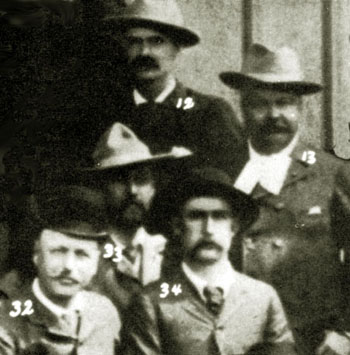 Top, Phil Dufran
Top, Phil Dufran
Center Left, Fred Hesse; Upper Center Right, Frank Wolcott
Lower Left, Richard Allen; Lower Right, Frank Canton
|
Phil DuFran fled to Arizona where he worked for the Hashknife. He ultimately returned to the Dakotas and for a while acted as
a representative of Rosenbaum Brothers of Chicago. Later he operated a saloon in Le Beau, South Dakota.
With the construction of a spur line into LeBeau, the town became the major shipping point for the giant
Matador Land and Cattle Company. During the summer of 1909, 150,000 head were shipped out through
LeBeau It was said that the saloon took in more money during the season than
did the local bank. On December 11, 1909, a bartender, "Bud" Stephens, in DuFran's saloon shot David G. "Dode" Mackenzie twice in
the chest.
Mackenzie was the son of Murdo Mackenzie, the legendary general manager of the Matador. As
Dode staggered out the door of the saloon, the bartender pumped another two bullets into Dode's back.
Bud was tried for murder. Murdo Mackenzie hired one of the highest priced lawyers available to
prosecute Stephens. DuFran could only afford a young, still wet-behind-the-ears, 23 year-old attorney to
defend Stephens. The jury was composed of homesteaders who had no use for the Matador. In March, Stephens
was acquitted -- self defense. The Matador shipped all of its cattle from elsewhere. About two months following the
acquittal, a major portion of the town burned down -- arson by persons unknown. In 1924, the railroad reported that its expenses in ooperating
the line to Le Beau was $7,939.87 with revenues of $467.00 including $2.00 from passenger fares. With no cattle to ship, the
Chicago, Milwaukee & St. Paul pulled up its tracks. In 1950, Frank Donovan in his "Mileposts of the Prairie,"described the town:
"[T]he car jounced up Main Street Hill to the Center of Town. The road was hardly visible, but the two concrete sidewalks, each ten feet wide, from the top of the hill down to the railroad were intact."
There, his guide explained pointing to two rubble filled holes, "was Phil Du Fran's saloon where Dode Mackkenzie was shot!"
The town has not exactly dried up -- it
is now under the waters of the Oahe Reservoir.
By the end of the year, Hubert E. Teschemacher and Frederic O. DeBillier, liquidated the Teschemacher and DeBillier Cattle Company, owners of
the Duck Bar Ranch. While being held pending trial, DeBillier suffered from a mental breakdown allegedly as a result of the
thin air in Wyoming. Acting
Governor Barber had him released to seek a lower elevation to regain his mental faculties. It was, indeed,
a common belief among physicians of the day that exposure to high altitude could bring on
insanity. In 1899, Dr. Charles H. Solier, Superintendent of the State hospital for the insane in
Evanston, found it necessary to address the subject in a paper delivered in Laramie,
Is Altitude an Etiolgical Factor in Insanity? .
Although Dr. Solier found no evidence to support the belief, he noted "Throughout the greater part of the Rocky Mountain
country there is a prevalent belief that prolonged residence in that region
favors the development of functional nervous and mental diseases. Personally
1 know that this opinion has a strong foothold among the laity, especially throughout
southern Wyoming, and that it is shared by very many if not by all of the physicians of that
section. Seldom indeed does a case of insanity develop in which either high altitude is not
alleged as the exciting cause or a removal to sea level is not advised as a therapeutic measure."
Dr. Soler noted the prevelent claim that merely crossing Sherman
Hill could bring on insanity.
DeBillier left for
France where he died in 1935. His partner Teschemacher also left for France but after several
years returned to the United States, presumably cured of any manic tendancies.
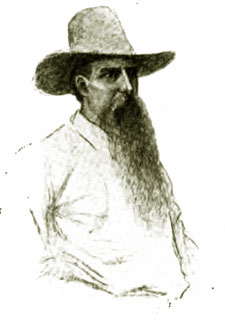 Arapahoe Brown
Arapahoe Brown
|
Fred Hesse remained in Wyoming and after several years returned to Johnson County to manage his ranch. In 1906, he switched
his operations to sheep. He served as Highway Commissioner 1927-1928 and died in 1929.
Thomas Smith returned to the Indian Territory and became a deputy United States Marshal. He was
shot to death on November 4, 1892, on a train in Indian Territory when he entered a
coach reserved for blacks.
Mike Shonsey, in 1893, had a confrontation with Dudley Champion at a cowcamp near
Manville. At the end of the confrontation, Champion lay dead, his gun unfired, jammed with
dirt. Shonsey turned himself in to authorities in Douglas and claimed self-defense. He was
released and moved to Nebraska where he became a successful stock grower.
Frank Canton went to Nebraska and Alaska. He ultimately returned to Oklahoma and became deputy marshal for Judge Isaac Parker. In 1907,
he became adjudent general of the Oklahoma National Guard, serving until he died in
1927. Following his death, it was revealed that his real name was Joe Horner, a
wanted outlaw, murderer, and bank robber.
The "Texas Kid," was hanged after he killed his wife following an
argument relating to his adventures in Wyoming.
Elias W. "Pops" Whitcomb was struck dead along the Belle Fourche by a lightening bolt on Jan. 1, 1915.
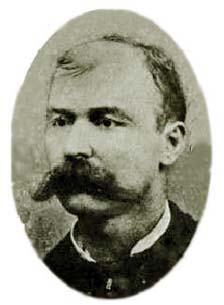 William "Red" Angus
William "Red" Angus
|
Sheriff Angus was defeated for reelection and took a job tending bar at the Occidental Hotel.
Later, however, he served as deputy clerk and county treasurer. In 1893, he engaged in a
shootout with Arapahoe Brown in the street in front of the hotel. Neither was a very good shot.
Doc Will Frackleton, a circuit riding dentist was in town and witnessed the fight from the
doorway of the hotel. Bullets flew into the barroom while the customers ducked for cover. When the fight was over, Doc commented to
Angus as to the .45's Angus and Araphoe were firing, "Well I don't see what in hell you
carry those things for. You fellows can't hit anything with them. The comment struck Angus and Arapaho funny and relieved the
tension. All three went into the bar and ordered drinks. Frackleton, p. 42.
Pending trial of the Invaders, the two trappers Ben Jones and Bill Walker, as material
witnesses to the murder of Champion and Ray, were placed in
protective custody in the Converse County Jail in Douglas. By some mysterious means, they were
broken out of the jail and taken to Nebraska by a local liveryman working for the cattlemen. Wyoming authorities learned of the flight to
Nebrakska, and telegraphed ahead to have the two taken into custody. Hugo Donzelman, a high-powered lawyer for cattle interests
in Cheyenne, arranged for the two to be taken to Chadron by special train where a local judge granted a writ of habias corpus. Donzelman was
formerly the territorial attorney-general. To preclude the two from being seized by
Wyoming authorities, the two were immediately taken into custody by an assistant United States marshal and taken to
Omaha on an alleged charge of selling liquor to Indians. According to Nebraska historian
A. E. Sheldon, "A Nebraska Episode of the Wyoming Cattle War," Nebraska State Historical Society, 1899, the writ
of habeas corpus was issued upon the deposit of $120.00 with the judge to "meet all possible costs."
Sheldon noted that no accounting of the money and no record of the writ has ever been found. In Omaha,
the two were supposedly given $3,000.00 each and placed on a train and sent to St. Louis from whence they disappeared.
Jack Flagg gave up ranching and moved into Buffalo to publish the Voice Newspaper.

Kaycee, 1912
In 1897, John Nolan, owner of the K C, sold a portion of the ranch just to the north of the burnt remains of the
cabin to a cooperative group for construction of a general mercantile, the Powder River Commercial Company. In addition to the
mercantile, a blacksmithy and a saloon were established on the site. The mercantile allegedly sold provisions to
members of the Hole-in-the-Wall gang and the saloon acted as their watering hole when they came into town.
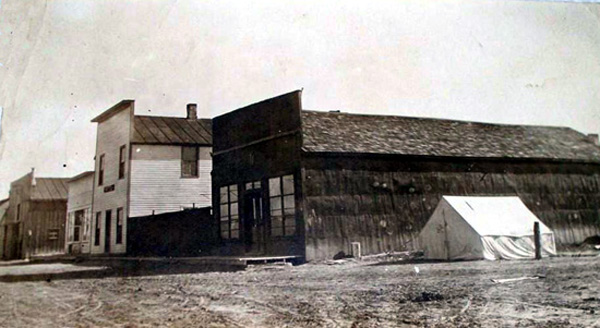
Kaycee, undated.
In 1906, allegedly as a result of legal restrictions on
saloons in unincorporated areas, the little community was incorporated as the Town of Kaycee (the post office
department required the name to be spelled out)./p>
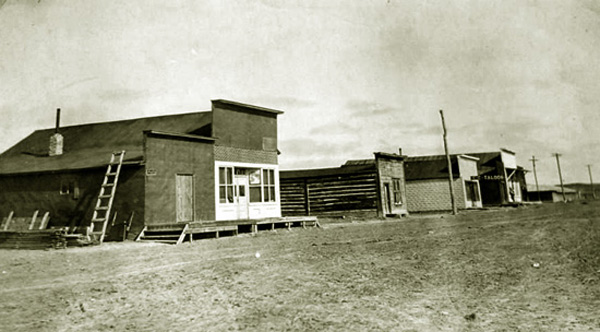
Kaycee, undated.
The saloon burned down in 1928. The mercantile was sold to the
paternal grandfather of President Gerald Ford and later became a Grange hall.
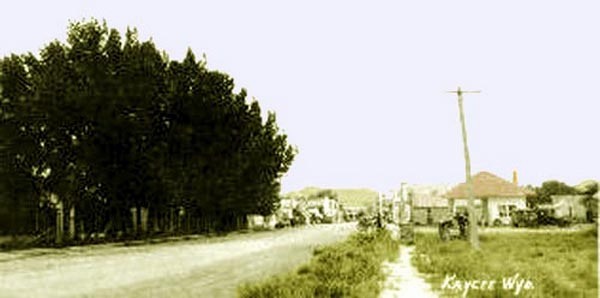
Kaycee, 1937
Debate rages to this day as to who had advance knowledge. Among those contended to have
known in advance are Acting Governor Barber, Sen. Warren (denied by him), and Sen. Carey (it was believed
that the foreman of the CY cut the telegrah wires).
Finally, was there a "Red Sash Gang" of which Nate Champion was a member? Probably not. The reference to such a
"gang" was more likely an after the fact attempt by the large cattle interests to justify their actions by
portraying the invasion as an effort to eliminate a gang of rustlers that Johnson County
authorities would not bring to justice. The reference to a red sash comes from the report by
Chicago Herald reporter Sam Clover that Nate Champion was wearing a red sash when he
was killed.
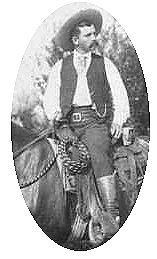 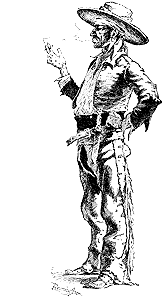 Left, Addison Spaugh wearing sash; right Mexican vaquero with sash.
Left, Addison Spaugh wearing sash; right Mexican vaquero with sash.
In actuality, the use of a sash, in lieu of a belt, was at the time a common item of
cowboy apparel, dating back to the Quebecois voyageurs and coureurs de bois employed by the
Hudson's Bay Company and Mexican vaqueros. Their use was picked up by American
mountain men, such as Joe Meek. Washington Irving in his 1837 Adventures of Captain Bonneville observed of
the early mountain man that there was
"girt around his waist * * * a red sash, in which he bestows pistols, knife, and the stem of his Indian pipe; preparations for either peace or war."
Charles Polk Wells described the attire of the plainsman following the Civil War:
I dressed myself in the plainsman's garb--of the period--which consisted of a combero [Sic}, a blue flannel shirt embroidered
down the front, buckskin coat and breeches with long fringe dangling at the outer seams, black silk handkerchief for a
necktie, and a red silk sash--Mexican style--which passed several times around my slender waist, crossed in front with
the ends tucked under at the side to allow the long fringe to hang over the hips. The sash suspended the
ivory handled pistols. On the right side hung my long Spanish knife, also my beaded bullet pouch and powder flask, the
latter suspended by a silk cord passed over the left shoulder.Wells, Polk: Life and Adventures of Polk Wells, the Notorious Outlaw, p. 39.
At the same time, Mexican vaqueros used sashes. Much of our modern
cowboy attire such as chaps (from chaparejos) and cowboy hats, were adopted by Texan cowboys from their
Mexican counterparts. Thus, many cowboys used a red sash including Montana cowboy artist
Charlie Russell and James B. "Wild Bill" Hickok who carried two pearl gripped revolvers in
his sash, grips out, cross-draw fashion. Hickok's use of a red sash earned him
the appellation, the "pimp marshal."
Thus, although references to a "Red Sash Gang" appear in literature with regard to
cowboys in the Powder River Basin, Brown's Hole, and with regard to the dispute between
ranchers and miners in Tombstone, Ariz., there has been no definitive evidence that the use of
a red sash was other than a sartorial affectation.
Next page, Tom Horn
|